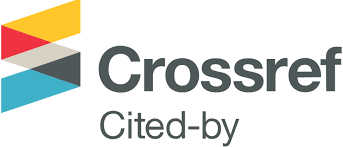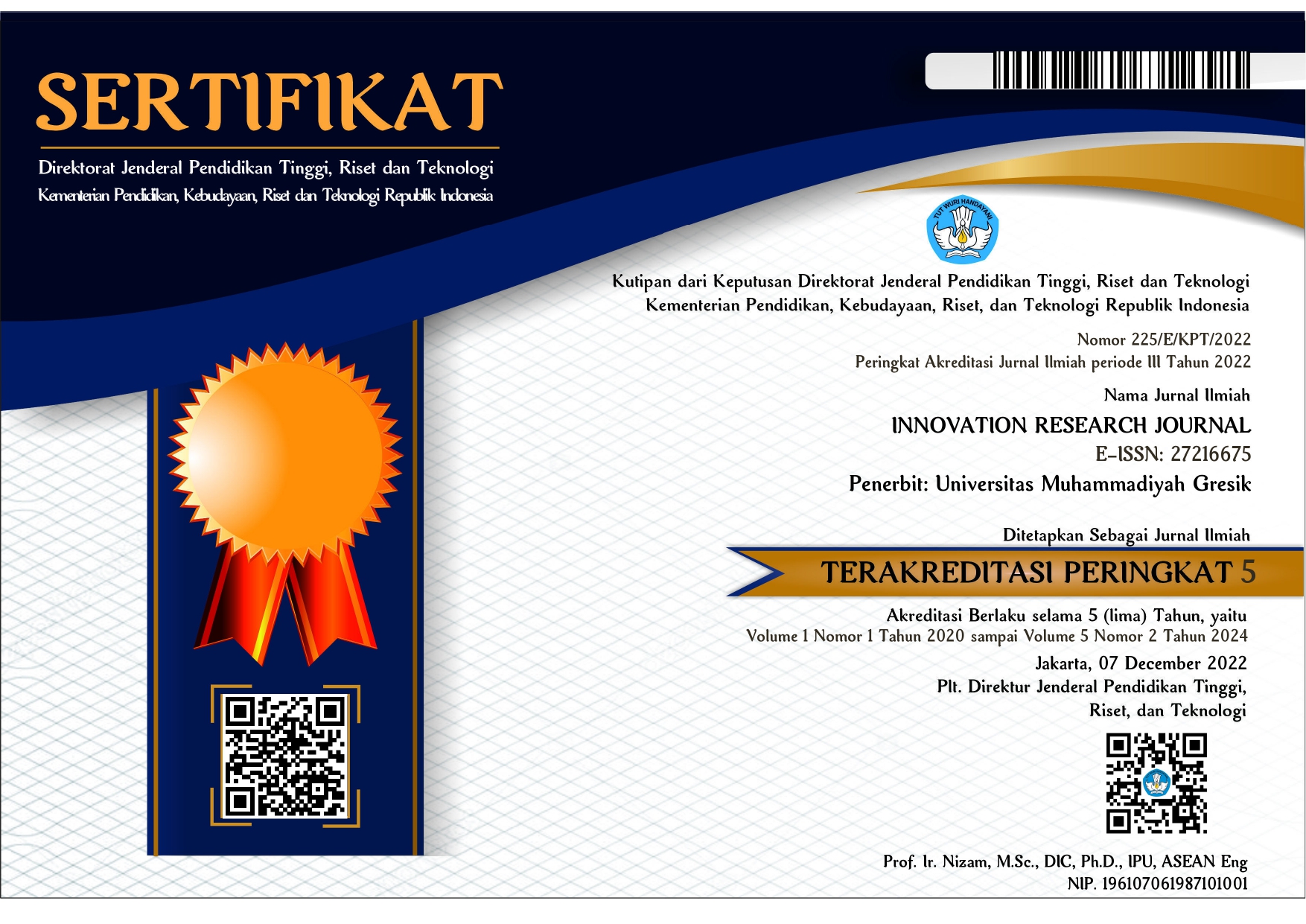The Relationship of Stroke Incidents With Clients’ Quality of Life
DOI:
https://doi.org/10.30587/innovation.v5i2.8398Keywords:
Keywords : Stroke, Quality of Life, ClientsAbstract
Stroke is a condition where the blood supply to the brain is disrupted or reduced due to blockage (ischemic stroke) or rupture of blood vessels (hemorrhagic stroke). Stroke can cause physical disability, this can affect psychological, emotional, cognitive and even social conditions. So post-stroke sufferers will experience changes in their quality of life. The aim of this research is to analyze the relationship between the incidence of stroke and the quality of life of clients at RSUD Ibnu Sina Gresik. This research uses an observational research design with a cross sectional approach. The total population was 451 clients, 82 samples were studied using consecutive sampling techniques. The instrument used in the research was the WHOQOL-BREF questionnaire and then the collected data was analyzed using the SPSS Chi-Square Test. Almost all of the stroke clients who were controlled at the neurological clinic at Ibnu Sina Gresik Regional Hospital experienced a stroke once, 62 (75.6%) of the clients and almost all of the quality of life of stroke clients who were controlled at the neurological clinic at Ibnu Sina Gresik Regional Hospital experienced a fairly good quality of life. 66 (80.5%) clients. The results of the collected data were then analyzed to obtain P = 0.624 > 0.05, so H1 was rejected and H0 was accepted. In conclusion, there is no relationship between the incidence of stroke and the quality of life of clients at Ibnu Sina Gresik Regional Hospital.
Keywords : Stroke, Quality of Life, Clients
References
Asmila, L., Septiwantary, R., & Nuraenah. (2021). Depresi Pada Pasien Paska Stroke. Indonesian Journal of Nursing Sciences and Practices, 1, 27–32.
Choriqoh, A., Sani, A. F., & Kurniawan, D. (2022). Recurrent stroke syndrome without abnormality on magnetic resonance imaging caused by stenosis of middle cerebral artery: A case report. Radiology Case Reports, 17(8), 2771–2774. https://doi.org/10.1016/j.radcr.2022.05.008
Destriande, I. M., Faridah, I., Oktania, K., & Rahman, S. (2021). Faktor Yang Mempengaruhi Kualitas Hidup Pada Lanjut Usia. Jurnal Psikologi Wijaya Putra, 2, 1–9.
Ekasari, M. F., Riasmini, N. M., & Hartini, T. (2019). Meningkatkan Kualitas Hidup Lansia Konsep dan Berbagai Strategi Intervensi (1st ed.). Wineka Media.
Hafdia, A. N. A., Arman, Alwi, M. K., & Asrina, A. (2018). Analisis Kualitas Hidup Pasien Paska Stroke Di RSUD Kabupaten Polewali Mandar. Sinergitas Multidisiplin Ilmu Pengetahuan Dan Teknologi, 1, 111–118.
Kasma, Safei, Ki., Zulfahmidah, Rachman, M. E., & Mappaware, N. A. (2022). Pengaruh Kepatuhan Menjalani Rehabilitasi Terhadap Peningkatan Kekuatan Otot Pada Pasien Pasca Stroke. Jurnal Mahasiswa Kedokteran, 2(5), 359–367.
Kemenkes RI. (2018). Hasil Utama Riskesdas 2018. Kementerian Kesehatan Republik Indonesia. https://kesmas.kemkes.go.id/assets/upload/dir_519d41d8cd98f00/files/Hasil-riskesdas-2018_1274.pdf
Muin, F. F., Sari, D. J. E., & Has, D. F. S. (2022). Pengaruh Terapi Musik Klasik Terhadap Tingkat Depresi Pada Lansia Di Langkap Burneh Bangkalan. Indonesian Journal Of Professional Nursing, vol 3, 64–71.
P2PTM Kemenkes RI. (2019). Hari Stroke Sedunia 2019 : Otak Sehat, SDM Unggul. Kementerian Kesehatan Republik Indonesia. https://p2ptm.kemkes.go.id/tag/hari-stroke-sedunia-2019-otak-sehat-sdm-unggul
Parinding, D. (2018). Penyebab terjadinya stroke berulang. Alodokter.Com. https://www.alodokter.com/komunitas/topic/stroke-batang-otak
Paskahlin, A. P., Febriana, P., Suprapti, B. J. D., & Kase, G. B. (2022). Stroke: Kualitas Hidup Pasien Stroke dan Bagaimana Meningkatkannya. Buletin KPIN. https://buletin.k-pin.org/index.php/arsip-artikel/1178-stroke-kualitas-hidup-pasien-stroke-dan-bagaimana-meningkatkannya
Pittara. (2022a). Demensia. Alodokter.Com. https://www.alodokter.com/demensia
Pittara. (2022b). Pengertian Stroke. Alodokter.Com. https://www.alodokter.com/stroke
Putri, A. E. R. (2022). Penyakit Stroke: Gejala, Penyebab, dan Cara Mengobatinya. Mitrakeluarga.Com. https://www.mitrakeluarga.com/artikel/penyakit-stroke
Rachmawati, D., Marshela, C., & Sunarno, I. (2022). Perbedaan faktor resiko penyebab stroke pada lansiadan remaja. Bali Medika Jurnal, 9, 207–221. https://doi.org/https://doi.org/10.36376/bmj.v9i3
Rahayu, S., Utomo, W., & Utami, S. (2014). Hubungan Frekuensi Stroke Dengan Fungsi Kognitif. Jom Psik, 1, 1–10.
Rismawan, W., Lestari, A. M., & Irmayanti, E. (2021). Gambaran Kualitas Hidup Dan Karakteristik Pasien Pasca Stroke Di Poli Syaraf RSUD Dr. Soerkardjo Kota Tasikmalaya. Jurnal Kesehatan Bakti Tunas Husada, 21.
Rochmah, T. N., Rahmawati, I. T., Dahlui, M., & Dll. (2021). Economic Burden of Stroke Disease: A Systematic Review. Int. J. Environ. Res. Public Health, 18. https://doi.org/https://doi.org/10.3390/ijerph18147552
Rohmah, A. I. N. R., Purwaningsih, & Bariyah, K. (2012). Kualitas hidup lanjut usia. Jurnal Keperawatan, 3(2), 120–132.
Salsabila, R. (2023). Laki-laki Lebih Berisiko Terserang Stroke? Ini Faktanya. CNBC Indonesia. https://www.cnbcindonesia.com/lifestyle/20230313193416-33-421333/laki-laki-lebih-berisiko-terserang-stroke-ini-faktanya
Santika, E. F. (2023). Stroke dan TBC Masuk dalam 10 Penyakit Penyebab Kematian Tertinggi di Indonesia. Databoks.Katadata.Co.Id. https://databoks.katadata.co.id/datapublish/2023/02/07/stroke-dan-tbc-masuk-dalam-10-penyakit-penyebab-kematian-tertinggi-di-indonesia
Savitri, T. (2021). Apa yang Terjadi pada Pasien Setelah Stroke Berlalu? Hellosehat.Com. https://hellosehat.com/saraf/stroke/pasca-stroke/
Sulaeman, S. (2018). Benarkah Stroke Lebih Banyak Menyerang Laki-laki? Ini Kata Dokter. Detikhealth.Com. https://health.detik.com/berita-detikhealth/d-3880375/benarkah-stroke-lebih-banyak-menyerang-laki-laki-ini-kata-dokter
Vihandayani, M., Wiratmo, P. A., Hijriati, Y., Studi, P., Keperawatan, I., & Binawan, U. (2019). Hubungan Dukungan Keluarga Sebagai Support Sistem Dan Kualitas Hidup Relations Between Family Support As a System Support and Life Quality in. 1, 74–79.
WHO. (2012). WHOQOL: Measuring Quality of Life. Who.Int. https://www.who.int/tools/whoqol
Widiharti, Widiyawati, W., Zahroh, & Janah, N. H. (2021). Peningkatan Kebisaan Berperilaku Sehat Lansia Menuju Lansia Sehat Dan Bahagia. Jurnal ADIMAS, 121–126.
Widiharti, Widiyawati W, Sari DJE, & Zuhroh DF. (2019). Peer group peningkatan kesehatan lansia menuju lansia yang sehat dan bahagia. Prosiding Seminar Nasional, 296–301.









